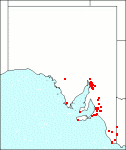Family: Orchidaceae
Microtis unifolia
Citation:
Reichb, f., Beitr. Syst. Pfl. 62 (1871).
Synonymy: Ophrys unifolia Forster f., Fl. Insul. Aust. Prod. 59 (1786); Epipactis porrifolia Sw., K. Svenska Vet. Acad. Handl. 21:233 (1800); M. porrifolia (Sw.)R. Br. ex Sprengel, Syst. Veg. 3:713 (1826); M. frutetorum Schltr., Linnaea 20:568 (1847).
Common name: Common onion-orchid.
Description:
Plant 5-80 cm high, slender to robust; stem erect, green to green-yellow, fleshy; leaf lamina hollow, 8-60 cm long, 2-12 mm diam., exceeding the raceme if undamaged; apex acuminate, erect or drooping.
Flowers spreading, 6-100, numerous on well developed plants; spike rather dense, pale-green or golden-green, 2-20 cm long, 1-3 mm diam.; pedicel 1-1.5 mm long; ovary ovoid, 2-10 x 1.2-3 mm, erect, standing out from the scape; dorsal sepal ovate to orbicular, 2-4 x 1-2 mm, margin evenly rounded or with a recurved tip, ovate-cucullate, obtuse or contracted near the apex to a sharp point; lateral sepals linear-oblong to ovate-lanceolate, 1.5-2.5 x 0.8-1.2 mm, subacute, rolled or recurved; petals falcate-lanceolate to ovate-lanceolate, 1.4-1.8 x 0.4-0.8 mm, spreading, partly concealed by a dorsal sepal; labellum sessile, oblong, 1.2-2.5 x 0.4-2 mm, pendulous or recurved against the ovary, only rarely narrowed at mid-length; tip 2-fid, truncate or emarginate, not apiculate, margin crenulate to rugulose, sometimes thickened 'but rarely undulate; basal calli saddle-shaped, 0.2-0.8 x 0.2-0.4 mm long, flat rather than convex, usually continuous at the sides with a narrow band of callus behind a slit-like transverse furrow; anterior callus prominent, c. 3 mm diam., variously developed, verrucose or papillose; remainder of lamina minutely tuberculate; column 1.2-1.5 mm long, erect or decurved, base often broader than at the stigma; anther hemispherical, with a minute point; the auricles ovate, distinct, blunt, reaching about half-way up the anther; stigma prominent, semilunate; rostellum conspicuous, triangular, viscid; pollinia friable, attached directly or via a short caudicle to the rostellum, easily detached.
Published illustration:
Fitzgerald (1884) Australian orchids vol. 2, pt 1 as M. porrifolia; Cunningham et al. (1982) Plants of western New South Wales, p. 200; Hoffman & Brown (1984) Orchids of south-west Australia, p. 236.
|
|
Distribution:
|
Forms small to very extensive colonies in a wide range of habitats from swamps to dry ridges and from off-shore islands to inland creeks. Often in disturbed areas as in pine plantations.
W.Aust.; Qld; N.S.W.; Vic.; Tas. New Zealand; Polynesia; Indonesia and East Asia to Japan.
|
Conservation status:
native
Flowering time: Aug. — Jan.
|

SA Distribution Map based
on current data relating to
specimens held in the
State Herbarium of South Australia
|
Biology:
Pollinated mainly by tiny wasps or more rarely by ants but also self-pollinated and often apomictic.
Taxonomic notes:
A very common and variable species which may hybridise with M. parviflora and M. rara but due to their small size and similar appearance it is very difficult to recognise actual hybrids.
Author:
Not yet available
|

